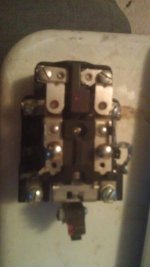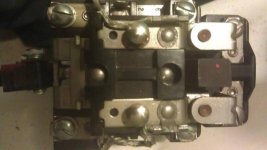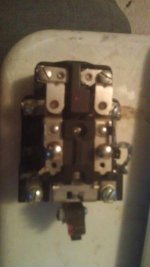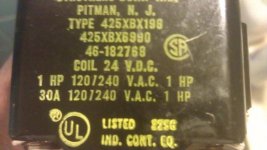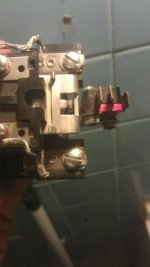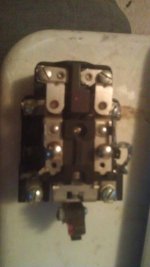You are using an out of date browser. It may not display this or other websites correctly.
You should upgrade or use an alternative browser.
You should upgrade or use an alternative browser.
flipflop relay help
- Thread starter marmarb
- Start date
Where the hell did you find that thing? I've been doing this a looonnnggg time, and have never seen a relay with a micro switch mounted on it. Did you see that it had a 24vdc coil?
*edit* Having a 24vdc coil means that it will only work with control circuits that are 24 volts, direct current. They won't work with conventional timers.
*edit* Having a 24vdc coil means that it will only work with control circuits that are 24 volts, direct current. They won't work with conventional timers.
Hydrolized
Member
Okay so should i just buy a flip flop
No, just buy the proper relay. Get one with a 120v coil. (or 240v if your running a 240v timer).
You could also use a 24v DC transformer plugged into your 120v timer.
There's no way to put the 24vdc relay onto a timer to turn on the lights when you want. You need a 120v coil relay so it can be turned on with a simple digital wall trimmer.. You need to buy the right kind of relay.
I dont see how a transformer would work. You need to be able to turn the coil on/off with a timmer. Pluging in a 120v timmer into the 24vdc transformer wont turn it on to send power to the realy ad power on the lights. You need a timmer to contrl the 24vdc power that turns the coil on/off. If im missing something please more info on what you mean..
I dont see how a transformer would work. You need to be able to turn the coil on/off with a timmer. Pluging in a 120v timmer into the 24vdc transformer wont turn it on to send power to the realy ad power on the lights. You need a timmer to contrl the 24vdc power that turns the coil on/off. If im missing something please more info on what you mean..
Last edited:
This is what im using. 120v 50a 2p contactor

These are built better but do the same 120v 50a dp relay


These are built better but do the same 120v 50a dp relay

Essentially what you are looking for, and different manufactures produce the same style of relay, so specific model numbers are useful only to an extent ... I suppose if you want to do internet ordering. Most local electric supply stores carry these in stock...
But look for a DPDT = double pole - double throw relay

dank.Frank
But look for a DPDT = double pole - double throw relay
dank.Frank
Last edited:
sx646522
Member
Ahhh, one of our old competitors. 
I gotta say...this thread made me lol.
So, you bought an ol' Struthers-Dunn 30A DPDT relay off of eBay, and didn't know what it was, or have any previous experience with running control circuits?
And this is why stoners and credit cards don't mix, people.
-----
Please, please, please, folks...don't ever buy anything online, if you don't know how to use it beforehand.
Don't feel too bad; our Application Engineers (and Sales Engineers, also) got calls like this all the time. I just wish people would ask how to use this stuff beforehand, instead of (essentially) wasting their time - and money.
-SX
P.S. If you're not sure, use a 'done-for-you' solution instead.
I gotta say...this thread made me lol.
i dunno what that means lol i just got it off ebay i didnt wanna have to buy one of them regular commercial flip boxes rather if i did it myself id always know how to do it
So, you bought an ol' Struthers-Dunn 30A DPDT relay off of eBay, and didn't know what it was, or have any previous experience with running control circuits?
And this is why stoners and credit cards don't mix, people.
-----
Please, please, please, folks...don't ever buy anything online, if you don't know how to use it beforehand.
Don't feel too bad; our Application Engineers (and Sales Engineers, also) got calls like this all the time. I just wish people would ask how to use this stuff beforehand, instead of (essentially) wasting their time - and money.
-SX
P.S. If you're not sure, use a 'done-for-you' solution instead.
Hydrolized
Member
DPDT = Double Pole, Dual Throw.
You could use a 120v to 24v transformer to pull the coil in from a timer, they would work but it sounds like your electrical experience is limited. I set up an old flipper with some old parts from a dumpster dive after a dry cleaners business cleared out, it too was operated by a 24v coil.
Good luck, Peace
Good luck, Peace
The relay is 24v DC. He might be able to find a wall wart power supply that give him that, but a transformer is for AC only - they will not function on DC. However, most contacts in timers are going to be rated for AC only, not DC. He needs to buy the correct relay if he still wants to build his own.
The coil to pull the relay in is 24v DC, the relay it self is rated 30 amps 120/240 VAC or 1 hp 120/240 VAC, check pics again. The contacts are rated to "pull in" a AC voltage whilst being triggered by a low voltage switch my friend. They do make 120 volt to 24 volt transformers, what do you think doorbell ringers operate off of. All he would have to do is find said transformer and hook it up to a timer that energizes the transformer to pull in the coil, switching on his 240v ballast. The transformer and coil have essentially no load on em, while the contacts take the brunt of abuse switching the lights.
Good luck, Peace
Good luck, Peace
Sorry, Rowdy, but you are incorrect. Transformers rely on the relative motion of lines of magnetic flux from alternating current to work. Doorbell transformers work on 24v AC, the same as sprinkler valves, etc.
From wikipedia, emphasis is mine -
By appropriate selection of the ratio of turns, a transformer thus enables an alternating current (AC) voltage to be "stepped up" by making Ns greater than Np, or "stepped down" by making Ns less than Np. The windings are coils wound around a ferromagnetic core, air-core transformers being a notable exception.
http://en.wikipedia.org/wiki/Transformer
From wikipedia, emphasis is mine -
By appropriate selection of the ratio of turns, a transformer thus enables an alternating current (AC) voltage to be "stepped up" by making Ns greater than Np, or "stepped down" by making Ns less than Np. The windings are coils wound around a ferromagnetic core, air-core transformers being a notable exception.
http://en.wikipedia.org/wiki/Transformer
Adding a diode to a transformer would make a very rudimentary half-wave rectified DC power supply which would allow the use of the present part.
That or find a 120VAC to 24VDC power supply from a portable electronic device... clip the connector off the wire and wire the supply for proper polarity to the 24VDC coil
That or find a 120VAC to 24VDC power supply from a portable electronic device... clip the connector off the wire and wire the supply for proper polarity to the 24VDC coil
Adding a diode to a transformer would make a very rudimentary half-wave rectified DC power supply which would allow the use of the present part.
That or find a 120VAC to 24VDC power supply from a portable electronic device... clip the connector off the wire and wire the supply for proper polarity to the 24VDC coil
A diode or a full-wave bridge could be added to make it work, but then you still have the issue of switching DC with AC-rated contacts. DC rated contacts have a "wiping" motion inherent to their make-break action to keep the oxidation deposited on the face of the contacts by DC to a minimum. Yes, the AC side could be switched and then rectify the downstream portion of the circuit, but it would be a clusterfuck. Better to get the correct components - I paid about $8 each for Dayton DPDT 40a relays with 120vac coils on eBay.

